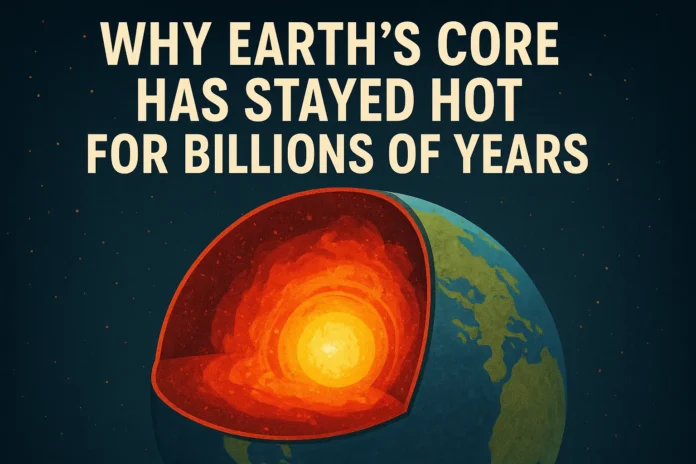When you dig beneath Earth’s surface, the temperature keeps rising until you reach the scorching hot core, where conditions are almost as extreme as the surface of the Sun. But how can Earth’s inner core remain so hot for over 4.5 billion years?
Scientists have studied this mystery for decades, and today we know that the planet’s fiery interior has two major sources of heat that keep it alive and active.
Earth’s Structure: From Crust to Core
Looking at Earth from the surface downward, the planet is divided into several distinct layers:
- The Crust – the thin, solid outer shell where we live.
- The Mantle – a vast layer of hot rock that slowly moves and flows.
- The Outer Core – composed mainly of liquid iron and nickel.
- The Inner Core – a solid sphere made mostly of iron, compressed under enormous pressure.
As you move deeper, the temperature rises dramatically. At about 2,900 kilometers beneath the surface, near the boundary between the mantle and the outer core, temperatures reach around 2,700°C (4,900°F). Go further down, and by the time you reach the boundary between the outer and inner core, the temperature soars to nearly 6,000°C (10,800°F)—roughly the same as the Sun’s surface.
Why Doesn’t the Heat Escape?
Normally, heat dissipates into space over time. If Earth’s core were a simple hot ball sealed inside, it should have cooled by now. Instead, the core remains intensely hot because of two powerful heat sources:
- Primordial Heat from Earth’s Formation
Around 4.5 billion years ago, Earth formed from the collisions of countless rocky and metallic bodies in the early solar system. These violent impacts generated huge amounts of energy, heating the young planet until much of it melted. Some of this primordial heat escaped into space, but a large fraction became trapped deep inside Earth, where it remains locked away. - Radioactive Decay of Isotopes
Scattered throughout Earth’s interior are unstable radioactive isotopes such as potassium-40, thorium-232, uranium-235, and uranium-238. As these isotopes break down, they release energy in the form of heat. This steady release of nuclear energy acts like a natural furnace, continuously warming Earth’s interior.
The Role of Radioactive Isotopes in Plate Tectonics
These radioactive elements do more than just generate heat. They also fuel plate tectonics, the process that drives earthquakes, volcanoes, and mountain building. Without radioactive decay, Earth’s mantle would be cooler and more rigid, possibly preventing the movement of tectonic plates.
In other words, Earth’s geological activity—from volcanic eruptions to the slow drift of continents—is possible largely because of the energy released by these decaying isotopes.
Extreme Heat, Extreme Pressure
At the core, even though temperatures are hotter than molten metal, the enormous pressure keeps much of the inner core solid. Scientists describe Earth’s interior as a delicate balance between temperature and pressure:
- High temperatures try to melt the metals.
- Crushing pressures keep them compact and solid.
This unique balance explains why the outer core is liquid while the inner core remains solid.
Why Earth’s Core Matters
The hot, dynamic core plays a critical role in making Earth habitable:
- It powers the geodynamo, the process that generates Earth’s magnetic field, shielding us from harmful solar radiation.
- It drives volcanic activity, recycling materials between Earth’s surface and its depths.
- It fuels plate tectonics, shaping continents and creating diverse environments for life.
Without a hot core, Earth would be geologically dead, similar to Mars or the Moon.
Conclusion: A Planet That Stays Alive
In summary, Earth’s core has stayed hot for billions of years due to:
- Primordial heat left over from Earth’s violent formation.
- Radioactive decay of isotopes inside the mantle and core.
This constant energy source ensures that our planet remains active, its surface reshaped by volcanoes, earthquakes, and moving continents. The same inner fire that began 4.5 billion years ago continues to burn, making Earth a living planet rather than a cold, dead rock.

